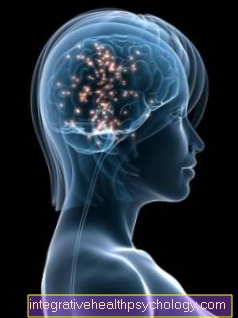Drooping eyelid
introduction
The drooping eyelid, or ptosis in technical terms, is the lower position of the upper eyelid. The eyelid cannot be pulled up arbitrarily. This can be a muscular weakness or it can be caused by a nerve. A weak connective tissue of the skin is also possible. Affected people can have impaired vision and often suffer psychologically from the misalignment of the face. If the drooping eyelid is causing discomfort, a small, relatively low-risk operation can help.

root cause
Drooping eyelids can be caused by a variety of causes. The most common reason is age. With age, the skin and connective tissue become less elastic and the thin skin on the eyelid can no longer be pulled up completely. This usually occurs on both sides and a familial accumulation can also be observed.
However, drooping eyelids are not just a change with age, they can also be congenital. In children with droopy eyelids, it is most often a congenital disorder. Either the responsible cranial nerve is not properly developed or the eyelid lifting muscle is not properly developed.
Various chronic diseases can also lead to unilateral or bilateral drooping eyelids. These diseases can affect both the muscles, in this case the eyelid lifter, and the nerves. One such disease is the neuromuscular disease myasthenia gravis. However, those affected usually also have other symptoms.
If your eyelids droop suddenly, you should see a doctor as soon as possible or call the emergency services. In the case of other unilateral symptoms in particular, a stroke can be the cause and in this case immediate treatment in a neurological clinic is necessary.
Other possible causes of a suddenly drooping eyelid are encephalitis or meningitis. Immediate medical treatment is also necessary in this case. Children can also have strokes, which is why a doctor should always be consulted here.
One-sided drooping eyelid
If only one eyelid is hanging, the causes can be narrowed down. Pure old age of the skin is rather unlikely. Neurological diseases must be excluded here, especially if they occur suddenly.
Are possible especially
- Strokes
- Cerebral hemorrhage
- Brain inflammation
The most common cause is a stroke caused by a blocked blood vessel and is one of the most common illnesses in Germany that trigger the need for care. A differentiation must first take place in the clinic, since it is always an emergency, which requires immediate hospital treatment. The cause of the one-sided limitation lies in the anatomy of the brain. The human brain is made up of two halves, each of which controls the opposite half of the body. Most areas in the brain are therefore duplicated. In the case of damage, such as a stroke, often only one half of the brain is affected and its functionality is accordingly limited. In a typical stroke caused by a blocked blood vessel, the damage often remains one-sided, while inflammation can spread to the entire brain.
Further information is available under our topic: stroke
In congenital ptosis, a drooping eyelid can also be unilateral, as both sides do not necessarily have to have a developmental disorder. Even if a drooping eyelid develops slowly, an imaging examination of the head should be carried out, since structures that take up space, such as abscesses or tumors that exert pressure on one side, should be excluded.
thyroid
The thyroid is a usually soft, small organ in the neck area. With changes such as a large goiter or thyroid cancer, this organ can increase in size significantly. It is possible that other structures, such as nerves, are affected. The thyroid can restrict the sympathetic nervous system on the head, for example. If this sympathetic system fails, the person affected shows a series of neurological deficits. This also includes Horner's syndrome, which is made up of the drooping eyelid (ptosis), a small pupil (miosis) and a sunken eyeball (enophthalmus). This is usually a one-sided disorder, as the sympathetic system is also located on both sides and only one area is narrowed. In addition to the drooping eyelid, there is often hoarseness, difficulty swallowing and a clearly palpable and visible thyroid gland. In the case of ptosis and other of the symptoms listed, a medical evaluation is necessary. If thyroid changes are known, regular ultrasound examinations should be carried out by the family doctor. In older age, this is part of the normal check-ups at the family doctor.
More on this: Thyroid disease
After botox
Botox is a powerful neurotoxin produced by the bacterium Clostridium botulinum. In cosmetic surgery, this neurotoxin is sometimes used to tighten skin folds. If botox gets near nerves, these can be paralyzed, which leads to failures in the areas to be supplied. This can also affect the eyelid lifter during facial treatments. Even botox poisoning through food can lead to nerve paralysis throughout the body. Small muscles are the first to be affected. Double vision is an early sign and drooping eyelids can also occur in the early phase. In the event of sudden double vision and ptosis after consuming canned food, a doctor should be consulted immediately.
Muscle weakness
Muscle weakness can result from a chronic illness or from old age. Myasthenia gravis is a possible disease of the muscles, which can lead to drooping lids. This often occurs in childhood. The muscle weakness can also be a result of nerve-damaging toxins. This has been observed with botox and also with some snake poisons. In old age there is often no specific cause for the sagging of the song lifter to be found.
also read: Muscle weakness
Through stress
Stress can have many sequelae in the body. Stress can act as a risk factor for strokes and other circulatory disorders and thus secondarily trigger ptosis. Even with known neuromuscular diseases, increased stress can trigger a flare-up and also lead to drooping eyelids. However, there is no known direct link between increased stress and drooping eyelids.
After a stroke
A stroke is either a blocked blood vessel in the brain or bleeding. In both cases there is an undersupply and death of nerve cells on one side. Depending on the location in the brain, various failure symptoms are possible. The best known picture is the so-called hemiplegia, which also affects the eyelid lifting muscle. Affected people have drooping eyelids and often paralyzes the entire half of their face. A stroke is a very time-critical emergency and the failures can only be reversed with timely treatment, so emergency services should be called in the event of sudden ptosis. In some people, the symptoms of failure, including ptosis, persist for life.
More on this: Signs of stroke
Concomitant symptoms
The symptoms that accompany ptosis depend on the cause. Age-related ptosis usually only shows wrinkled, inelastic skin all over the body.
In the case of a stroke, the other symptoms depend on the extent to which the damage has spread. Sufferers may develop complete hemiplegia of the side of the body, have speech disorders, drool and appear confused. The symptoms usually appear close together and suddenly. With encephalitis and meningitis, clouding of consciousness and a stiff neck are more likely to be observed. High fever and general symptoms of illness also occur.
After a botox poisoning, ptosis is an early warning sign and those affected develop paralysis all over the body, including the respiratory muscles. Thyroid disease, when ptosis occurs, is often accompanied by hoarseness and mood swings. Furthermore, changed hormone levels of the thyroid hormones are known and can lead to weight changes and fatigue. The symptoms accompanying ptosis are just as variable as the causes and allow conclusions to be drawn about these causes.
therapy
When treating droopy eyelids, the cause also matters. Treatment is often not necessary for age-related weak connective tissue. An operation can only be considered if the eyelids restrict the view or if the person concerned is psychologically suffering from ptosis. It is a very small and relatively low-risk procedure. Moisturizers can be used for prevention, but this is not a guarantee that ptosis will not occur. In stroke patients and brain inflammation, the cause must be eliminated. A clogged vessel can be cleared with blood-thinning medication, and encephalitis must be treated with antibiotics. If these measures are successful in time, the ptosis disappears on its own. Combating the causes is also in the foreground in the case of thyroid diseases. After poisoning with Botox, drugs can be given that bind the free poison.However, the already bound poison cannot be eliminated and those affected have to be treated in intensive care until the poison is broken down. In the case of congenital droopy eyelids, surgery is usually the only way to help those affected. As in old age, this is only necessary if there are complaints.
A temporary therapy option is the use of tapes for the eyelids. They can lift the eyelid and thus enlarge the field of vision again.
When do you need an operation?
Surgery to lift or tighten the eyelids is only necessary if the eyelids are blocking your view. However, surgery can also be done for cosmetic reasons if sufferers suffer from the hanging songs. Since this operation is a very small and low-risk procedure, it is often performed for these cosmetic reasons. During the operation, the eyelid lifting muscle is corrected.
More information on this: Eyelid lift
What does an operation cost?
In the event of a medically necessary tightening or correction, the health insurance company will cover the costs. This is particularly the case with the impaired vision caused by the drooping eyelid. For cosmetic operations, the costs are between 1200 and 3600 euros, depending on the procedure. These costs include complete care before and after the operation. The exact costs should be discussed with the attending physician.
diagnosis
The diagnosis of ptosis itself is purely clinical. The drooping eyelid is more of a symptom of other diseases than an independent disease and is immediately recognizable from the outside. In the following, however, some examinations must be carried out in order to make the actual diagnosis. In particular, imaging methods are required to examine the brain. A blood test can also reveal whether it is poisoning. In most cases, ptosis is accompanied by other specific and non-specific symptoms, which limits the diagnosis.
forecast
The prognosis for ptosis depends on the cause and the type of treatment. After a surgical correction, the prognosis is very good and those affected usually do not suffer from droopy eyelids again. In stroke patients, the prognosis depends on the start of treatment. With early treatment, all symptoms of failure can recede, while with later treatment the damage remains permanent. In the case of encephalitis, too, the start of treatment is crucial for survival and the possible regression of neurological damage such as ptosis.





























